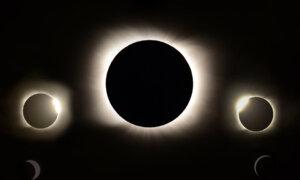A total solar eclipse is more than just the moon covering the sun; it’s a multi-phase spectacle that can cause a number of unusual phenomena, if the weather is right.
In the past, eclipses were often associated with bad omens and misfortune. In 1133, for example, a solar eclipse over England was later seen as a portent of the king’s death — which occurred two years later — and the ensuing civil war. While the mechanism of an eclipse is now understood, many of the associated effects remain bizarre.
Around 20 minutes before the total eclipse, it will begin to get noticeably darker, and around 30 seconds to a minute before the totality — when the moon appears to completely cover the sun — shadow bands can be observed.
“They’re like waves of light appearing on the ground, a bit like the waves of light you can observe at the bottom of a swimming pool in the sun. It’s a manifestation of the atmospheric turbulence,” said Marc Jobin, an astronomer at the Montreal Planetarium. “It’s an unusual phenomenon that can only be seen at this time.”
During the total eclipse, the temperature can suddenly drop several degrees and the wind can change direction. Clouds can also dissipate in the minutes before the total eclipse — so even if Apr. 8 starts out as a cloudy day, sky watchers may still be in luck — a phenomenon that researchers link to the cooling that occurs on Earth when the moon hides the sun
The minutes before the total eclipse on Apr. 8 afternoon could also be a great opportunity to observe planets, such as Venus and Jupiter, as the sky begins to darken, Mr. Jobin said.
“We’re going to see Venus a little below the eclipsed sun and Jupiter a little above,” said Mr. Jobin, an “eclipse hunter” who has witnessed 10 total solar eclipses and spent almost 33 minutes in the shadow of the moon. Mercury can also be seen as the total eclipse approaches, as can bright stars, such as Sirius and Capella.
While protective eclipse glasses should be worn while looking at the sun before and after the total eclipse, the planets can’t be seen through the glasses. “You can look at the sky during the partial phases without looking at the sun,” Mr. Jobin said. Looking in the direction of the sun without protective glasses can cause permanent injury and burns.
There are few scientific studies about the behaviour of animals during total eclipses, largely due to their rarity, however, there are numerous reports of animals acting strangely. For example, in 2017, The Associated Press reported that Galapagos tortoises at a zoo in Columbia, S.C., began mating at the height of an eclipse. The cause of the behaviour is not yet known.
Mr. Jobin said that when he was in the West Indies in 1998 to see an eclipse, roosters began crowing like it was morning when the sun returned. According to the website of Quebec’s chief scientist, “many birds stop singing and gather, or return to their nests as the darkness descends, behaviours similar to those they display at dusk.”
Researchers are planning to study the behaviour of 12 animal species at a zoo in Granby, Que., east of Montreal, during the eclipse and in the days around it.
Several seconds before the totality, and several seconds after, as the moon almost completely covers the sun, points of brilliant, often pink light, can be observed with eclipse glasses. Known as Baily’s beads, these pearls of light are caused by the mountains and craters of the moon.
Another phenomenon, the “diamond ring,” occurs when only one point of light can be observed before the sun disappears completely. Both of these phenomena can only be seen in the path of totality — a band where the moon’s shadow will be cast on the Earth.
Outside the path of totality, the sun will not be completely hidden by the moon and it will not become night during the day, Mr. Jobin said. “A 99.9 percent partial eclipse is not equivalent to 99.9 per cent of the experience” of a total eclipse, he said.







